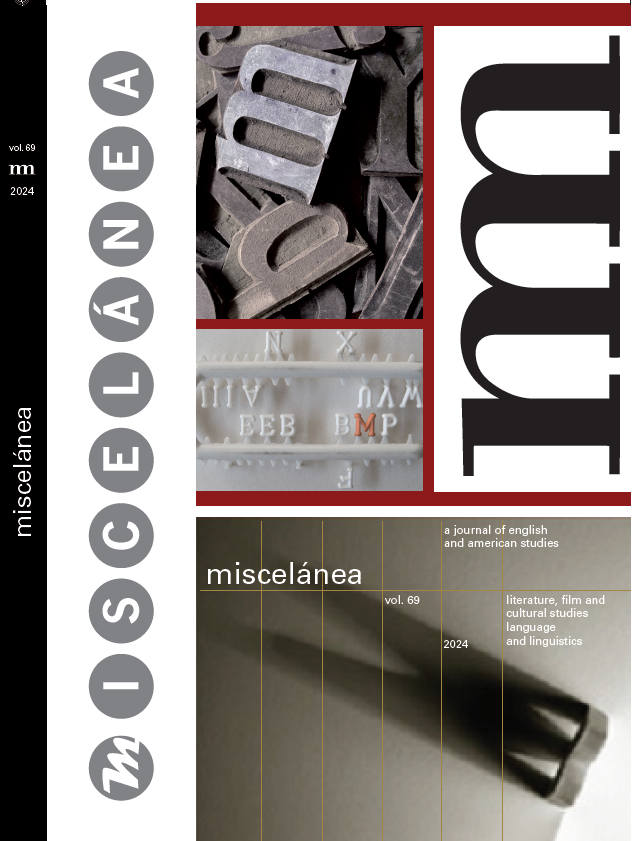Lexical Availability in Multilingual CLIL: Gender-dependent Differences in English and French
DOI:
https://doi.org/10.26754/ojs_misc/mj.20249559Keywords:
content and language integrated learning, gender, lexical availability, English as a foreign language, French as a foreign languageAbstract
It has been suggested that Content and Language Integrated Learning (CLIL) positively affects learners’ content-related vocabulary. While CLIL has become increasingly popular throughout Spain, the language of instruction in this learning environment has predominantly been English, largely to the neglect of other languages. Calls have consequently been made to conduct comparative research across other languages to better understand the strengths and weaknesses of CLIL irrespective of the language of instruction. In addition, female learners have been found to outperform males in areas of vocabulary such as lexical availability (LA) in English. However, given suggestions that CLIL may blur gender differences, it is unclear whether this difference is also found in a multilingual CLIL context. This study thus aims to determine whether an English advantage is observed in LA in a multilingual CLIL environment, and whether this advantage varies in male and female learners. Results indicate that there is a clear dominance in English over French, regardless of gender. However, analysis across different grades reveals that CLIL instruction has a clear effect on the students’ LA in different languages, but in different ways for male and female learners. The findings are of key importance to CLIL stakeholders wishing to support male and female learners in multilingual classrooms.
Downloads
References
AGUSTÍN LLACH, María del Pilar and Almudena FERNÁNDEZ FONTECHA. 2014. “Lexical Variation in Learners’ Responses to Cue Words: The Effect of Gender”. In Jiménez Catalán, Rosa María (ed.): 69-81. <https://doi.org/10.1007/978-94-007-7158-1_5>.
CANGA ALONSO, Andrés. 2017. “Spanish L1 Speakers’ and EFL Learners’ Available Lexicon”. Anuario de Estudios Filológicos 40: 5-23. <https://doi.org/10.17398/2660-7301.40.5>.
DALTON-PUFFER, Christiane. 2008. “Outcomes and Processes in Content and Language Integrated Learning (CLIL): Current Research from Europe”. In Delanoy, Werner and Laurenz Volkmann (eds.) Future Perspectives for English Language Teaching. Heidelberg: Carl Winter: 139-157.
DALTON-PUFFER, Christiane. 2011. “Content-and-Language Integrated Learning: From Practice to Principles?” Annual Review of Applied Linguistics 31: 182-204. <https://doi.org/10.1017/S0267190511000092>.
DÖRNYEI, Zoltán. 2007. Research Methods in Applied Linguistics. Oxford: Oxford U.P.
DÖRNYEI, Zoltán and Ali H. AL‐HOORIE. 2017. “The Motivational Foundation of Learning Languages other than Global English: Theoretical Issues and Research Directions”. The Modern Language Journal 101 (3): 455-468. <https://doi.org/10.1111/modl.12408>.
FERNÁNDEZ FONTECHA, Almudena. 2010. “Gender and Motivation in EFL Vocabulary Production”. In Jiménez Catalán, Rosa María (ed.) Gender Perspectives on Vocabulary in Foreign and Second languages. London: Palgrave Macmillan: 93-117. <https://doi.org/10.1057/9780230274938_5>.
FERNÁNDEZ ORÍO, Susana and Rosa María JIMÉNEZ CATALÁN. 2015. “Lexical Availability of EFL Learners at the End of Spanish Secondary Education: The Effect of Language Program and Prompt”. ES Revista de Filología Inglesa 36: 103-127.
GALLARDO-DEL-PUERTO, Francisco and Zeltia BLANCO-SUÁREZ. 2021. “Foreign Language Motivation in Primary Education Students: The Effects of Additional CLIL and Gender”. Journal of Immersion and Content-based Language Education 9 (1): 58-84. <https://doi.org/10.1075/jicb.19023.gal>.
GRADDOL, David. 2006. English Next. UK: British Council.
HERAS, Arantxa and David LASAGABASTER. 2015. “The Impact of CLIL on Affective Factors and Vocabulary Learning”. Language Teaching Research 19 (1): 70-88. <https://doi.org/10.1177/1362168814541736>.
JIMÉNEZ CATALÁN, Rosa María. 2014a. “Preface”. In Jiménez Catalán, Rosa María (ed.): v-ix.
JIMÉNEZ CATALÁN, Rosa María. (ed.) 2014b. Lexical Availability in English and Spanish as a Second Language. Dordrecht: Springer. <https://doi.org/10.1007/978-94-007-7158-1>.
JIMÉNEZ CATALÁN, Rosa María and María del Pilar AGUSTÍN LLACH. 2017. “CLIL or Time? Lexical Profiles of CLIL and non-CLIL EFL Learners”. System 66: 87-99.
JIMÉNEZ CATALÁN, Rosa María and Andrés CANGA ALONSO. 2019. “El Léxico Disponible en Inglés de Chicos y Chicas Españoles Adolescentes”. ELIA: Estudios de Lingüística Inglesa Aplicada 19: 157-176.
JIMÉNEZ CATALÁN, Rosa María and Tess FITZPATRICK. 2014. “Frequency Profiles of EFL Learners’ Lexical Availability”. In Jiménez Catalán, Rosa María (ed.): 83-100. <https://doi.org/10.1007/978-94-007-7158-1_6>.
JIMÉNEZ CATALÁN, Rosa María and Julieta OJEDA ALBA. 2009. “Girls’ and Boys’ Lexical Availability in EFL”. ITL International Journal of Applied Linguistics 158: 57-76. <https://doi.org/10.2143/ITL.158.0.2046920>.
LASAGABASTER, David. 2008. “Foreign Language Competence in Content and Language Integrated Courses”. The Open Applied Linguistics Journal 1: 30-41. <https://doi.org/10.2174/1874913500801010030>.
LYSTER, Roy and Susan BALLINGER. 2011. “Content-Based Language Teaching: Convergent Concerns across Divergent Contexts”. Language Teaching Research 15 (3): 279-288. <https://doi.org/10.1177/1362168811401150>.
MARTÍNEZ-ADRIÁN, María and Francisco GALLARDO-DEL-PUERTO. 2017. “The Effects of Language Typology on L2 Lexical Availability and Spelling Accuracy”. International Journal of English Studies 17 (2): 63-79. <https://doi.org/10.6018/ijes/2017/2/256411>.
NEILSON PARADA, Maryann. 2016. Lexical Availability in Diaspora Spanish: A Cross-generational Analysis of Chilean Swedes. PhD Dissertation. University of Illinois at Chicago, USA.
SAN ISIDRO, Xabier. 2018. “Innovations and Challenges in CLIL Implementation in Europe”. Theory into Practice 57 (3): 185-195. <https://doi.org/10.1080/00405841.2018.1484038>.
SANDU, Bianca Manuela and Konstantina KONSTANTINIDI. 2021. “Impact of Overseas Experience on Lexical Availability in English and Spanish as Foreign Languages”. In Barragán Martín, Ana Belén, María del Mar Molero Jurado, África Martos Martínez, María del Mar Simón Márquez, José Jesús Gázquez Linares and María del Carmen Pérez Fuentes (eds.) Innovación Docente e Investigación en Arte y Humanidades: Nuevos Enfoques en la Metodología Docente. Madrid: Dykinson: 1049-1058. <https://doi.org/10.2307/j.ctv2gz3whg.96>.
SANTOS DÍAZ, Inmaculada Clotilde. 2017. “Selección del Léxico Disponible: Propuesta Metodológica con Fines Didácticos”. Porta Linguarum: Revista Internacional de Didáctica de las Lenguas Extranjeras 27: 122-139. <https://doi.org/10.30827/Digibug.53965>.
SCHMITT, Norbert. 2000. Vocabulary in Language Teaching. Cambridge: Cambridge U.P.
ŠIFRAR KALAN, Marjana. 2014. “Slovene Students’ Lexical Availability in English and Spanish”. In Jiménez Catalán, Rosa María (ed.): 125-138. <https://doi.org/10.1007/978-94-007-7158-1_8>.
WEI, Li and Melissa G. MOYER. 2009. The Blackwell Guide to Research Methods in Bilingualism and Multilingualism. Oxford: Blackwell. <https://doi.org/10.1002/9781444301120.ch22>.
Downloads
Published
How to Cite
Issue
Section
License
Copyright (c) 2024 Leah Geoghegan

This work is licensed under a Creative Commons Attribution-NonCommercial 4.0 International License.
Accepted 2023-11-09
Published 2024-06-24


